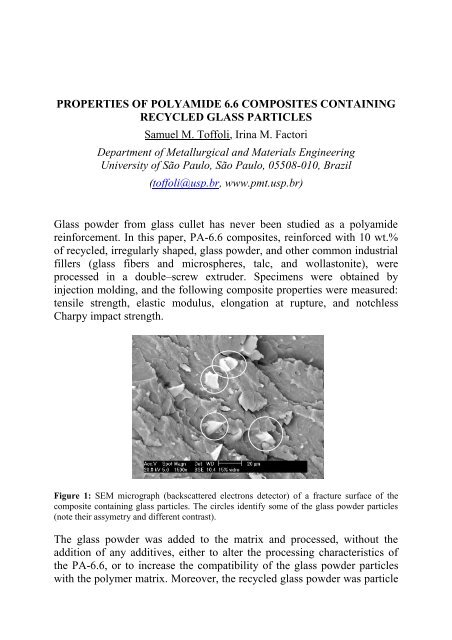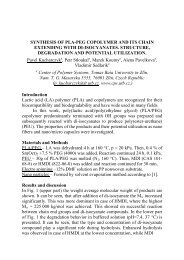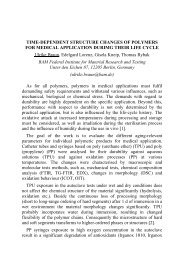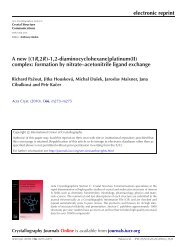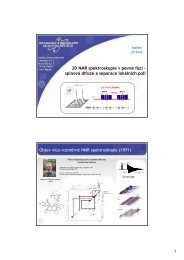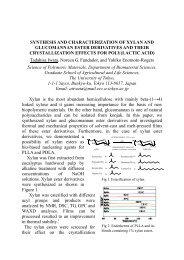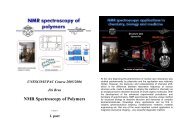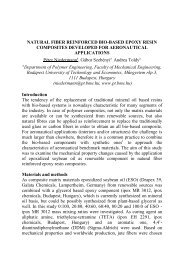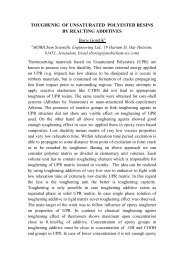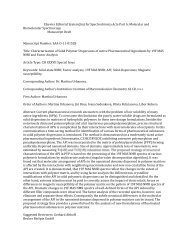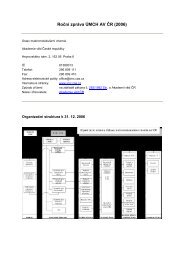Properties of polyamide 6.6 composites containing recycled glass ...
Properties of polyamide 6.6 composites containing recycled glass ...
Properties of polyamide 6.6 composites containing recycled glass ...
Create successful ePaper yourself
Turn your PDF publications into a flip-book with our unique Google optimized e-Paper software.
PROPERTIES OF POLYAMIDE <strong>6.6</strong> COMPOSITES CONTAINING<br />
RECYCLED GLASS PARTICLES<br />
Samuel M. T<strong>of</strong>foli, Irina M. Factori<br />
Department <strong>of</strong> Metallurgical and Materials Engineering<br />
University <strong>of</strong> São Paulo, São Paulo, 05508-010, Brazil<br />
(t<strong>of</strong>foli@usp.br, www.pmt.usp.br)<br />
Glass powder from <strong>glass</strong> cullet has never been studied as a <strong>polyamide</strong><br />
reinforcement. In this paper, PA-<strong>6.6</strong> <strong>composites</strong>, reinforced with 10 wt.%<br />
<strong>of</strong> <strong>recycled</strong>, irregularly shaped, <strong>glass</strong> powder, and other common industrial<br />
fillers (<strong>glass</strong> fibers and microspheres, talc, and wollastonite), were<br />
processed in a double–screw extruder. Specimens were obtained by<br />
injection molding, and the following composite properties were measured:<br />
tensile strength, elastic modulus, elongation at rupture, and notchless<br />
Charpy impact strength.<br />
Figure 1: SEM micrograph (backscattered electrons detector) <strong>of</strong> a fracture surface <strong>of</strong> the<br />
composite <strong>containing</strong> <strong>glass</strong> particles. The circles identify some <strong>of</strong> the <strong>glass</strong> powder particles<br />
(note their assymetry and different contrast).<br />
The <strong>glass</strong> powder was added to the matrix and processed, without the<br />
addition <strong>of</strong> any additives, either to alter the processing characteristics <strong>of</strong><br />
the PA-<strong>6.6</strong>, or to increase the compatibility <strong>of</strong> the <strong>glass</strong> powder particles<br />
with the polymer matrix. Moreover, the <strong>recycled</strong> <strong>glass</strong> powder was particle
size separated in standardized laboratory sieves, so that only the material<br />
<strong>containing</strong> particles less than 60 m were used in the study. Since <strong>glass</strong> is a<br />
brittle material, the particle size distribution <strong>of</strong> the powder is very wide,<br />
even reaching submicrometer sizes, in its small end. The limit size <strong>of</strong> 60<br />
m was chosen because that is a typical (industrial) <strong>glass</strong> sphere size used<br />
as a filler (in general, with a very narrow particle size distribution). Table 1<br />
summarizes the results.<br />
Table 1: Measured mechanical properties <strong>of</strong> the PA-<strong>6.6</strong> <strong>composites</strong>.<br />
Filler<br />
Elongation at<br />
Rupture (%)<br />
Tensile Strength<br />
(MPa)<br />
Elastic Modulus<br />
(MPa)<br />
Impact Strength<br />
(KJ/m²)<br />
No filler 5,3 ± 0,8 89 ± 1 3250 ± 69 208 ± 163<br />
Talc 8,5 ± 2,1 77 ± 1 4140 ± 201 75 ± 4<br />
Glass Fiber 2,4 ± 0,1 77 ± 1 4936 ± 175 29 ± 1<br />
Glass Microspheres 3,0 ± 0,3 74 ± 2 3334 ± 74 20 ± 1<br />
Wollastonite 12,2 ± 3,6 81 ± 1 4039 ± 106 89 ± 13<br />
Glass Powder 4,8 ± 1,0 78 ± 1 3676 ± 100 33 ± 13<br />
Standard ASTM D638–97 ASTM D638–97 ASTM D638–97 ISO 179-93<br />
The results indicate that it is possible to use particles <strong>of</strong> <strong>recycled</strong> <strong>glass</strong> with<br />
no surface modification in a PA-<strong>6.6</strong> matrix, once the final composite<br />
properties are compatible to the ones <strong>of</strong> <strong>composites</strong> <strong>containing</strong> usual<br />
commercial fillers, particularly <strong>glass</strong> microspheres<br />
References<br />
1. Jordan J., Jacob K., Tannenbaum R., Sharaf A. M.; Jasiuk I – Experimental trends in<br />
polymer nan<strong>composites</strong>, a review. Materials Science and Engineering, A 393, p. 1-11, 2005.<br />
2. Combette P., Ernoult I – Physique des polymères: structure, fabrication, emploi. Presses<br />
International Polytechnique, 2005.


